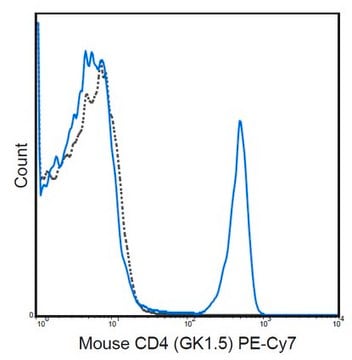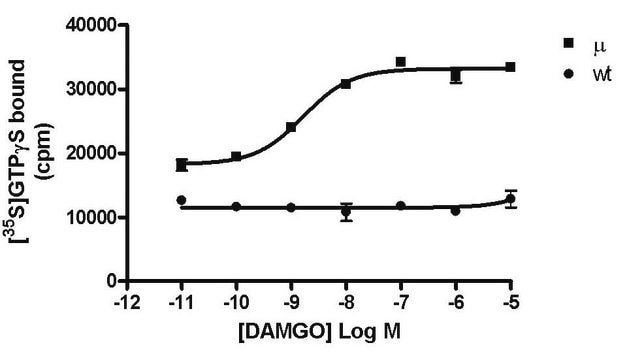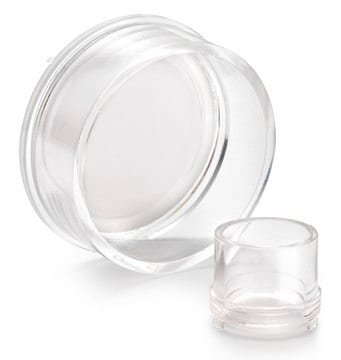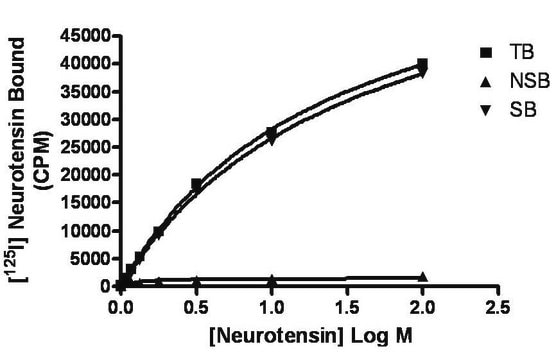HTS112M
ChemiScreen Recombinant Human Glucagon Receptor Membrane Preparation
Human glucagon / GCG GPCR membrane preparation for Radioligand binding Assays & GTPγS binding.
别名:
ChemiSCREEN Receptor Kit, Glucagon Receptor Membrane Prep, Human Glucagon Receptor Prep
登录查看公司和协议定价
所有图片(2)
About This Item
分類程式碼代碼:
41106514
eCl@ss:
32161000
NACRES:
NA.84
推荐产品
生物源
human
品質等級
重組細胞
expressed in Chem-1 cells
製造商/商標名
ChemiScreen
Chemicon®
技術
ligand binding assay: suitable (GTPγS)
radioligand binding assay (RLBA): suitable
NCBI登錄號
UniProt登錄號
運輸包裝
dry ice
一般說明
TRANSFECTION: Full-length human GCGR cDNA encoding Glucagon Receptor
HOST CELLS: Chem-1, an adherent mammalian cell line with no endogenous glucagon receptor expression.
HOST CELLS: Chem-1, an adherent mammalian cell line with no endogenous glucagon receptor expression.
Glucagon is a 29-amino acid peptide that stimulates glycogenolysis and gluconeogenesis in the liver to increase blood glucose. The receptor for glucagon is a class 2 (or class B) GPCR that signals through Gs to stimulate cAMP production (Mayo et al., 2003). Mice lacking the glucagon receptor have mild hypoglycemia after fasting, and exhibit hyperplasia of pancreatic α-cells (Gelling et al., 2003). Because of its role in promoting hyperglycemia, the glucagon receptor presents a potential target for treatment of diabetes. Chemicon′s glucagon receptor membrane preparations are crude membrane preparations made from our proprietary stable recombinant cell lines to ensure high-level of GPCR surface expression; thus, they are ideal HTS tools for screening of antagonists of glucagon receptor interactions and its ligands. The membrane preparations exhibit a Kd of 3.09 nM for [125I]-glucagon. With 1 nM [125I]-glucagon, 5 or 10 μg/well glucagon receptor Membrane Prep yields greater than 10-fold signal-to-background ratio.
品質
SPECIFICATIONS:
1 unit = 5 μg
Bmax for [125I] glucagon binding: 16.7 pmol/mg protein
Kd for [125I] glucagon binding: ~ 3.09 nM
Signal:background and specific binding values obtained in a competition binding assay with varying amounts of Glucagon receptor membrane prep:
1 unit = 5 μg
Bmax for [125I] glucagon binding: 16.7 pmol/mg protein
Kd for [125I] glucagon binding: ~ 3.09 nM
Signal:background and specific binding values obtained in a competition binding assay with varying amounts of Glucagon receptor membrane prep:
| 10 µg/well | 5 µg/well | |
|---|---|---|
| Signal:Background | 10.1 | 35 |
| Specific Binding (cpm) | 33315 | 36252 |
規格
Inucbation Conditions
RECOMMENDED ASSAY CONDITIONS: Membranes are mixed with radioactive ligand and unlabeled competitor in binding buffer in a nonbinding 96-well plate, and incubated for 1-2 h. Prior to filtration, a GF/C 96-well filter plate is coated with 0.33% polyethyleneimine for 30 min, then washed with 50mM HEPES, pH 7.4, 0.5% BSA. Binding reaction is transferred to the filter plate, and washed 3 times (1 mL per well per wash) with Wash Buffer. The plate is dried and counted.
• Binding buffer: 50 mM Hepes, pH 7.4, 5 mM MgCl2, 1 mM CaCl2, 0.2% BSA, filtered and stored at 4°C
• Radioligand: [125I]-glucagon (Perkin Elmer#:NEX-207)
• Wash Buffer: 50 mM Hepes, pH 7.4, 500mM NaCl , 0.1% BSA, filtered and stored at 4°C.
One package contains enough membranes for at least 200 assays (units), where a unit is the amount of membrane that will yield greater than 10-fold signal:background with [125I]-labeled glucagon at 1 nM
RECOMMENDED ASSAY CONDITIONS: Membranes are mixed with radioactive ligand and unlabeled competitor in binding buffer in a nonbinding 96-well plate, and incubated for 1-2 h. Prior to filtration, a GF/C 96-well filter plate is coated with 0.33% polyethyleneimine for 30 min, then washed with 50mM HEPES, pH 7.4, 0.5% BSA. Binding reaction is transferred to the filter plate, and washed 3 times (1 mL per well per wash) with Wash Buffer. The plate is dried and counted.
• Binding buffer: 50 mM Hepes, pH 7.4, 5 mM MgCl2, 1 mM CaCl2, 0.2% BSA, filtered and stored at 4°C
• Radioligand: [125I]-glucagon (Perkin Elmer#:NEX-207)
• Wash Buffer: 50 mM Hepes, pH 7.4, 500mM NaCl , 0.1% BSA, filtered and stored at 4°C.
One package contains enough membranes for at least 200 assays (units), where a unit is the amount of membrane that will yield greater than 10-fold signal:background with [125I]-labeled glucagon at 1 nM
外觀
Liquid in packaging buffer: 50 mM Tris pH 7.4, 10% glycerol and 1% BSA; no preservatives.
Packaging method: Membrane proteins were adjusted to 0.5 mg/ml in 1 ml packaging buffer, rapidly frozen, and stored at -80°C.
Packaging method: Membrane proteins were adjusted to 0.5 mg/ml in 1 ml packaging buffer, rapidly frozen, and stored at -80°C.
法律資訊
CHEMICON is a registered trademark of Merck KGaA, Darmstadt, Germany
儲存類別代碼
12 - Non Combustible Liquids
水污染物質分類(WGK)
WGK 2
閃點(°F)
Not applicable
閃點(°C)
Not applicable
Jiongwei Pan et al.
Cancer gene therapy (2021-01-28)
Significantly high-expressed circFLNA has been found in various cancer cell lines, but not in lung cancer. Therefore, this study aimed to explore the role of circFLNA in the progression of lung cancer. The target gene of circFLNA was determined by
Qiong Li et al.
International journal of stem cells, 14(4), 434-446 (2021-08-31)
MiR-148a-3p has been reported to regulate the differentiation of marrow stromal cell osteoblast. In this study, whether miR-148a-3p regulated the odontoblastic differentiation of human dental pulp stem cells (hDPSCs) or not was explored. The hDPSCs were isolated and identified via
Kelly E Mayo et al.
Pharmacological reviews, 55(1), 167-194 (2003-03-05)
Peptide hormones within the secretin-glucagon family are expressed in endocrine cells of the pancreas and gastrointestinal epithelium and in specialized neurons in the brain, and subserve multiple biological functions, including regulation of growth, nutrient intake, and transit within the gut
Chuanxin Zhang et al.
Cell cycle (Georgetown, Tex.), 20(19), 1953-1966 (2021-08-31)
Neohesperidin (NH) was reported to regulate osteoclastic differentiation, while LncRNA SNHG1 could inhibit osteogenic differentiation of bone marrow stromal cells (BMSCs). In this study, we aimed to explore whether SNHG1-mediated osteogenic differentiation could be regulated by NH. Osteonecrosis and adjacent
Shuai Yuan et al.
Drug design, development and therapy, 14, 5419-5430 (2020-12-17)
Neohesperidin (NH) and lncRNA HOTAIR (HOTAIR) could regulate osteoclastic and osteogenic differentiation. This study aimed to explore whether HOTAIR-mediated osteogenic differentiation was regulated by NH. Steroid-induced osteonecrosis of the femoral head (SONFH) mice model was established. Histopathological changes in mouse
我们的科学家团队拥有各种研究领域经验,包括生命科学、材料科学、化学合成、色谱、分析及许多其他领域.
联系技术服务部门







